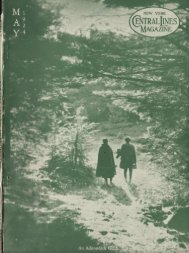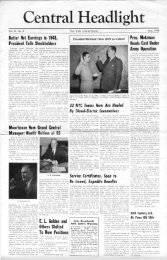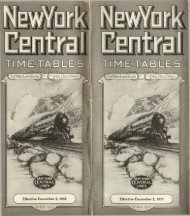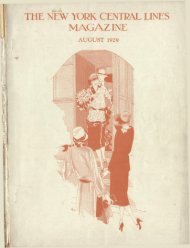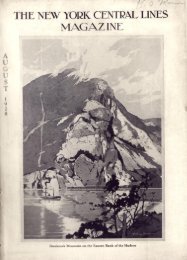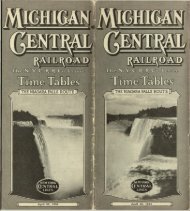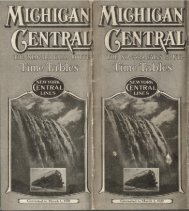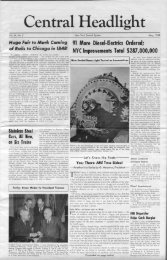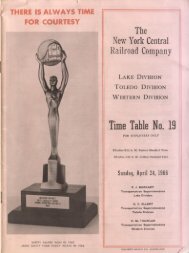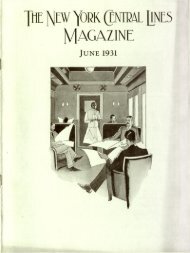Create successful ePaper yourself
Turn your PDF publications into a flip-book with our unique Google optimized e-Paper software.
•8<br />
BISON HEADS ADORN <strong>TH</strong>E<br />
Encircling the fifteenth story of the New York<br />
Central's new office building in New York is a herd<br />
of seventy-eight heads of the bison (popularly known<br />
as the American buffalo) in a design which presents<br />
a distinctively new note in American architectural<br />
decoration. Below each bison head, which is shown<br />
in detail in the inset, are three varieties of subsidiary<br />
decoration, depicting the winged helmet of Mercury,<br />
god of Commerce; the mallet and fasces, denoting<br />
Development and Power; a pendulum supporting the<br />
wheels of Progress; the winged wheel of Advancement;<br />
the scroll of Wisdom, and other symbols of<br />
Research, Discovery and Engineering Progress. The<br />
bison heads, which are done in terra cotta, staring<br />
Beauty of New Office Building in<br />
New York is Appreciated by<br />
Observer<br />
/^TO"ERE is one who finds New<br />
York beautiful," says a headline<br />
in the New York Times. And<br />
beneath this head is quoted a letter<br />
to the editor, in which the New York<br />
Central's mammoth new office building,<br />
spanning Park Avenue just north<br />
of Grand Central Terminal, is cited<br />
as one of the city's newest and most<br />
spectacular objects, of beauty.<br />
Signed by Harold Butcher of New<br />
York, the letter reads:<br />
"This afternoon I crossed Park<br />
Avenue at Fiftieth Street and, looking<br />
down toward the colossal building<br />
now going up at the Grand Central,<br />
I was suddenly arrested by the realization<br />
that its effect has been to turn<br />
Park Avenue into the nave of a<br />
mighty cathedral. Even the shadows<br />
playing about the tower of the new<br />
building contributed to the beautiful<br />
and fantastic effect.<br />
"Here, then, is another of the many<br />
instances of sudden beauty in this<br />
amazing city. One would hardly expect<br />
to have one's thoughts stimulated<br />
in the direction of the Cologne Cathedral<br />
while crossing Park Avenue.<br />
But such was my experience.<br />
"New York grows and grows: and<br />
she grows in startling and unexpected<br />
beauty."<br />
<strong>Railway</strong>s Reduce Freight Robberies<br />
91 Per Gent<br />
kOES the remarkable reduction<br />
which has occurred in losses of<br />
freight due to robbery throw some<br />
light on the comparative efficiency of<br />
our railways and our governments?"<br />
says the <strong>Railway</strong> Age. "Nobody<br />
claims, we believe, that our govern<br />
New York Central Lines Magazine for May, 1928<br />
NEW BUILDING IN NEW YORK<br />
down upon the hurrying crowds of the Terminal<br />
zone, have aroused the curiosity of thousands. The<br />
monumental building which they adorn now stands<br />
its full thirty-five stories high astride Park Avenue<br />
between Forty-fifth and Forty-sixth Streets. The<br />
last piece of steel was riveted into the structure<br />
April 5. When it is completed in January, 1929, it<br />
will house the executive offices of the New York<br />
Central and many firms of national reputation.. North<br />
and southbound traffic along Park Avenue will pass<br />
through the building and around two sides of Grand<br />
Central Terminal on ramps and viaducts. The.new<br />
office building which, "at the gateway to a continent,"<br />
is destined to become one of New York's<br />
landmarks, was designed by Warren & Wetmore.<br />
ments have _ recently reduced the<br />
amount of crime in the country, although<br />
the prevention of crime is one<br />
of their main functions; but the railways<br />
can point with pride to what<br />
railway police forces have accomplished<br />
in reducing losses of freight<br />
in transit resulting from robberies.<br />
"Under government operation of the<br />
railways, loss and damage to freight<br />
from all causes, including robberies,<br />
increased greatly and reached their<br />
maximum in 1920, in which year losses<br />
due to robberies from freight cars and<br />
other railroad property amounted to<br />
$12,726,947. Losses due to robberies<br />
have since been reduced until the corresponding<br />
figure for 1927 was only<br />
$1,151,136. In other words, in 1927<br />
they were less than 9 per cent of what<br />
they were in 1920."<br />
Safety that lasts is more important<br />
than Safety First. Form the habit.<br />
—H. C. Osborne, P. & L. E.<br />
New York Central Lines Magazine for May, 1928 39<br />
168 Years of New York Central<br />
Service in Family as John<br />
Anderson Retires<br />
TTOHN ANDERSON, Work Train<br />
Foreman on the Pennsylvania Division<br />
at Mahaffey, was retired February<br />
29, on pension, at the age of<br />
Mr. and Mrs. John Anderson<br />
sixty-five and after an unbroken<br />
period of forty-six years' faithful<br />
service.<br />
He first entered the service May<br />
10, 1882, as a laborer on the Fall<br />
Brook District, where he worked only<br />
a short time until he was transferred<br />
to the Beech Creek District. He was<br />
there promoted to foreman January<br />
25, 1884. He assisted in the construction<br />
of the Beech Creek Railroad, West<br />
Branch Valley Line, Curwensville &<br />
Bower Line and the Cherry Tree<br />
Branch. With the exception of a<br />
short period when he returned to the<br />
Fall Brook District to help in constructing<br />
the Corning Yards, he continued<br />
in service as foreman at various<br />
locations on the Beech Creek<br />
District until his retirement.<br />
An idea of his pride in his life<br />
work and the New York Central can<br />
be found from the fact that he brought<br />
up his five sons with New York Central<br />
service so instilled into them that<br />
every one of the five are employes<br />
of the New York Central: one a supervisor<br />
of track in the Electric Zone,<br />
New York; one an assistant supervisor<br />
of track; one a section foreman<br />
and one a section laborer on the<br />
Pennsylvania Division; and the other<br />
in the Transportation Department on<br />
the Adirondack Division. The combined<br />
service- of these five sons, together<br />
with the forty-six years of the<br />
father, totals 125 years' service to the<br />
New York Central. In addition, two<br />
sons-in-law and one grandson add<br />
forty-three years more to this total.<br />
A dinner was given him at Mahaffey<br />
on March 3 by a large number<br />
of his numerous friends at which time<br />
he was presented with a traveling bag<br />
and other useful remembrances.<br />
Mr. Anderson is in good health and<br />
will spend his retirement at his home<br />
in Mahaffey, Pa., with Mrs. Anderson.<br />
Joachim Lachat, Father of Four<br />
Central Men, Retires<br />
TOACHIM LACHAT, Section Laborer<br />
at Frenchville, Pa., was retired<br />
on pension December 31, having<br />
reached the age of seventy years.<br />
Mr. Lachat first entered the service<br />
as a section laborer at Frenchville<br />
August 26, 1912, and was in continuous<br />
service at that point as a<br />
laborer until his retirement. While<br />
his service with the Company has not<br />
been as many years as some, he is<br />
proud of his record and is a great<br />
booster for the New York Central.<br />
He has three sons who are now all<br />
working for the New York Central,<br />
and he had one son who was a train<br />
dispatcher on the Beech Creek District<br />
at the time of his death about two<br />
years ago.<br />
"Mr. Lachat has always been a<br />
faithful employe and a very competent<br />
track walker," said his division<br />
engineer, S. A. Seely.<br />
W. C. Christy, Ticket Agent at<br />
Oberlin, Retires<br />
I<strong>TH</strong> the best wishes of his superior<br />
officers and patrons, W.<br />
C. Christy, Ticket Agent at Oberlin,<br />
Ohio, retired March 1, after fortyfour<br />
years in railroad service.<br />
Mr. Christy was a messenger boy<br />
at Clyde in 1884, and was promoted<br />
to telegrapher in the following year.<br />
From then until receiving his last<br />
position at Oberlin, Mr. Christy has<br />
worked various stations on the line<br />
between Cleveland and Toledo, at the<br />
former terminal serving in the dispatcher's<br />
office. He was appointed<br />
ticket agent in 1900.<br />
His final day at the ticket window<br />
in Oberlin was marked by visits from<br />
friends who had worked with and<br />
known Mr. Christy for more than a<br />
quarter of a century.<br />
The local ems<br />
s ^ ^ B ployes of Oberlin<br />
^^^^^•JJjH presented Mr.<br />
Christy with a<br />
fountain pen on<br />
W t f ^ ,tH the eve of his re-<br />
H^^L_> JH tirement. Among<br />
BR1 JH the best wishes<br />
H » ^ B H expressed by citi-<br />
HMr'^fl zens of Oberlin,<br />
HikiH Hj was the following<br />
letter from John<br />
G. Olmstead, Secretary<br />
of the<br />
Alumni Associa-<br />
W. C. Christy tion of Oberlin<br />
College:<br />
"I note that you are retiring from<br />
active service with the New York<br />
Central and I cannot let the occasion<br />
go by without expressing a common<br />
citizen's appreciation of the fine personal<br />
and official service you have<br />
rendered here in Oberlin these many<br />
years. In all your service there has<br />
been marked geniality and willingness<br />
to do all possible for the accommodation<br />
of railroad patrons. Please accept<br />
my best wishes for many years<br />
of continued living in our midst."<br />
Mr. Christy is being succeeded at<br />
Oberlin by O. A. Betts of Elyria.<br />
George Glasco, on P. & E.,<br />
Retires<br />
T\/[rARCH 31, when he retired on<br />
pension, marked the termination<br />
of twenty-eight years of active and<br />
faithful service with the Big Four for<br />
George W. Glasco, Blacksmith at the<br />
Moorefield Shops of the Peoria &<br />
Eastern at Indianapolis. He entered<br />
the service of the Big Four at Wabash,<br />
Ind., in 1900, transferring to the<br />
P. & E. in 1921.<br />
His has been a life devoted to railroad<br />
service. He was born in Washington,<br />
D. C, March 31, 1858. When<br />
sixteen years of age he began his career<br />
as blacksmith with the Pennsylvania<br />
at Logansport, Ind. In 1886 he<br />
went to the Wabash at Peru, Ind.,<br />
and continued there after the Wabash<br />
became known as the L. E. & W. until<br />
1900. Since 1900 he has been in<br />
the continuous employ of the Big Four<br />
and P. & E.<br />
Says Mr. Glasco: "My connection<br />
with the Big Four and P. & E. has<br />
been most happy. A better gang of<br />
fellows, and a finer spirit of co-operation<br />
between the Company and employes<br />
is not to be found anywhere."<br />
On his last day of service, he received<br />
the best wishes and hearty congratulations<br />
of his fellow workers.<br />
Michael Fikley, Retired, Goes<br />
to Louisiana<br />
(T\& March 30, Michael Fikley got<br />
down from his train at Syracuse<br />
for the last time as a regular trainman<br />
on the New York Central. Then<br />
he went home, packed his grip and<br />
took another train for Baton Rouge,<br />
La., where his relatives live and where<br />
he is now resting up after fifty-one<br />
years on the road.<br />
When Mr. Fikley started braking in<br />
1877, matters weren't nearly so easy<br />
as nowadays, he comments. "I braked<br />
on the old Black Rock train from Albany<br />
to Syracuse and wore callouses<br />
half an inch thick on my hands, for in<br />
those days all trains were equipped<br />
with hand brakes. The old Black<br />
Rock had ten to twelve freight cars<br />
and a passenger train in the rear. It<br />
stopped at every station. I tell you, a<br />
man was tired after a day's run."<br />
Mr. Fikley was promoted to passenger<br />
brakeman in 1884, on the main<br />
line, and until his retirement worked<br />
between Albany and Syracuse. His<br />
home is at 144 Homecroft Road,<br />
Syracuse.<br />
At Rotterdam Junction the Stair family<br />
is happy together, since "Dad"<br />
Stair (F.A.) is no longer out every day<br />
on the road. He was recently retired<br />
by the New York Central after a long<br />
term of service as an engineman. With<br />
him here are shown Mrs. Stair and<br />
their son Floyd.





